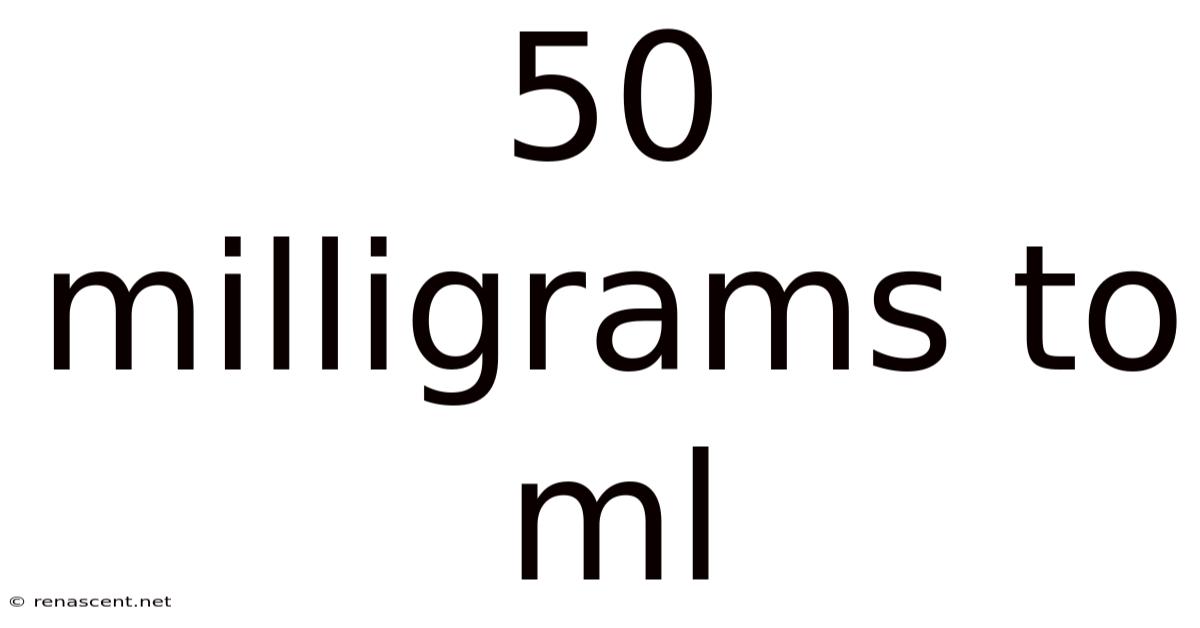50 Milligrams To Ml
renascent
Sep 20, 2025 · 4 min read

Table of Contents
Converting 50 Milligrams to Milliliters: Understanding the Importance of Density
Converting 50 milligrams (mg) to milliliters (ml) isn't a straightforward calculation like converting between units of the same dimension. Unlike converting meters to centimeters, where you simply use a fixed conversion factor, converting milligrams to milliliters requires knowledge of the substance's density. This article will thoroughly explain why, guide you through the process, explore common misconceptions, and answer frequently asked questions about this crucial concept in chemistry and other scientific fields.
Understanding the Difference: Mass vs. Volume
Before diving into the conversion, it's crucial to understand the fundamental difference between mass and volume.
-
Mass: Mass is the amount of matter in a substance. It's measured in units like grams (g), kilograms (kg), and milligrams (mg). A substance's mass remains constant regardless of its location or the gravitational pull acting upon it.
-
Volume: Volume is the amount of space a substance occupies. It's measured in units like liters (L), milliliters (ml), and cubic centimeters (cm³). The volume of a substance can change depending on factors like temperature and pressure.
The Role of Density in the Conversion
The link between mass and volume is density. Density is defined as the mass per unit volume of a substance. The formula is:
Density (ρ) = Mass (m) / Volume (V)
The unit for density is typically g/ml or g/cm³. To convert 50 mg to ml, we need to know the density of the substance in question. Different substances have different densities. For example:
- Water: has a density of approximately 1 g/ml at 4°C.
- Gold: has a significantly higher density than water, approximately 19.3 g/ml.
- Air: has a much lower density, approximately 0.0012 g/ml at sea level.
Without knowing the density, it's impossible to convert 50 mg to ml.
Step-by-Step Conversion Process
Let's illustrate the conversion process with an example using water. Remember, this process is applicable to any substance once you know its density.
1. Convert milligrams to grams:
Since density is typically expressed in g/ml, we need to convert 50 mg to grams:
50 mg * (1 g / 1000 mg) = 0.05 g
2. Use the density formula:
We know the mass (0.05 g) and the density of water (approximately 1 g/ml). We can rearrange the density formula to solve for volume:
Volume (V) = Mass (m) / Density (ρ)
3. Calculate the volume:
Substitute the values into the formula:
V = 0.05 g / 1 g/ml = 0.05 ml
Therefore, 50 mg of water occupies a volume of approximately 0.05 ml.
Important Note: This calculation is only accurate for water at approximately 4°C. The density of water changes slightly with temperature.
Converting for Other Substances
To convert 50 mg of a substance other than water to milliliters, you need to find the density of that specific substance. You can typically find this information in:
- Chemistry handbooks: Comprehensive reference books containing physical and chemical properties of various substances.
- Online databases: Numerous online databases, such as the NIST Chemistry WebBook, provide density information for a wide range of materials.
- Scientific literature: Research articles and publications often report the density of substances used in experiments.
Once you have the density (ρ) in g/ml, follow these steps:
- Convert milligrams to grams: Divide the mass in mg by 1000.
- Use the density formula: V = m/ρ
- Calculate the volume: Substitute the mass in grams and the density into the formula to find the volume in ml.
Common Misconceptions
Several misconceptions surround the conversion of milligrams to milliliters:
- Assuming a universal conversion factor: There's no single conversion factor between mg and ml. The conversion always depends on the density of the substance.
- Confusing mass and volume: Understanding the fundamental difference between mass and volume is crucial for accurate conversions. Mass measures the amount of matter, while volume measures the space occupied.
- Ignoring temperature and pressure: The density of a substance can change with temperature and pressure, particularly for gases. For accurate calculations, these factors should be considered.
Frequently Asked Questions (FAQ)
-
Q: Can I convert milligrams to milliliters without knowing the density?
A: No, it's impossible to convert milligrams to milliliters without knowing the density of the substance. Density is the crucial link between mass and volume.
-
Q: What if the density is given in different units (e.g., kg/L)?
A: You need to convert the density to g/ml before applying the formula. Use appropriate conversion factors to ensure consistent units throughout your calculation.
-
Q: How accurate are these conversions?
A: The accuracy of the conversion depends on the accuracy of the density value used. Density can vary slightly depending on factors like temperature and purity of the substance.
Conclusion
Converting 50 milligrams to milliliters requires understanding the concept of density. There's no universal conversion factor; you must know the density of the substance in question. This article has provided a detailed explanation of the process, highlighted common misconceptions, and answered frequently asked questions. By correctly applying the density formula, you can accurately determine the volume occupied by a given mass of any substance. Remember to always double-check your units and consider the potential influence of temperature and pressure on density for the most accurate results. Mastering this conversion is fundamental to many scientific and engineering calculations.
Latest Posts
Latest Posts
-
Valueerror Check Hostname Requires Server Hostname
Sep 20, 2025
-
Cm 2 In M2
Sep 20, 2025
-
Eagle Vs Hawk Size
Sep 20, 2025
-
Hot Chocolate On Spoon
Sep 20, 2025
-
100 Microliters To Ml
Sep 20, 2025
Related Post
Thank you for visiting our website which covers about 50 Milligrams To Ml . We hope the information provided has been useful to you. Feel free to contact us if you have any questions or need further assistance. See you next time and don't miss to bookmark.